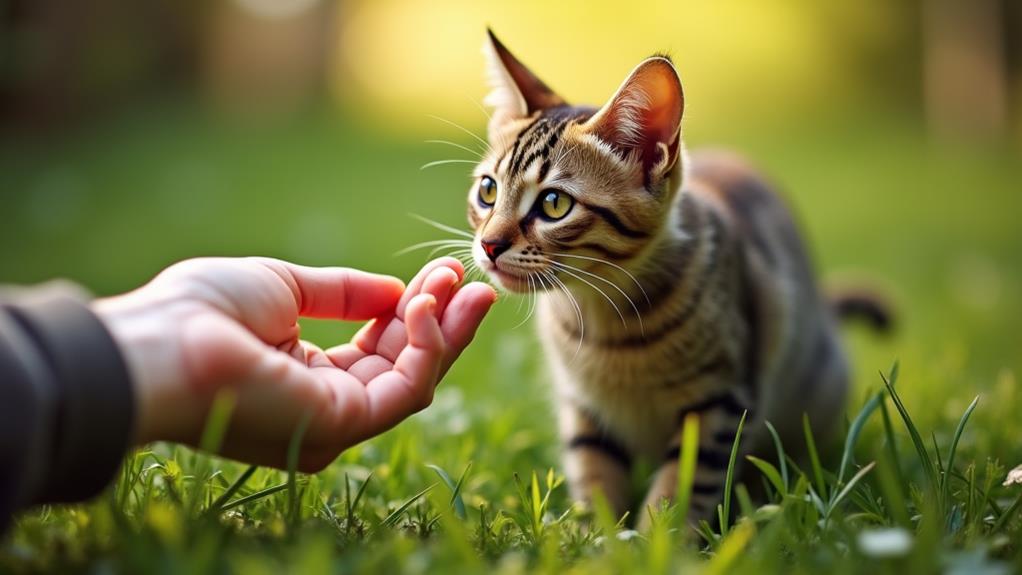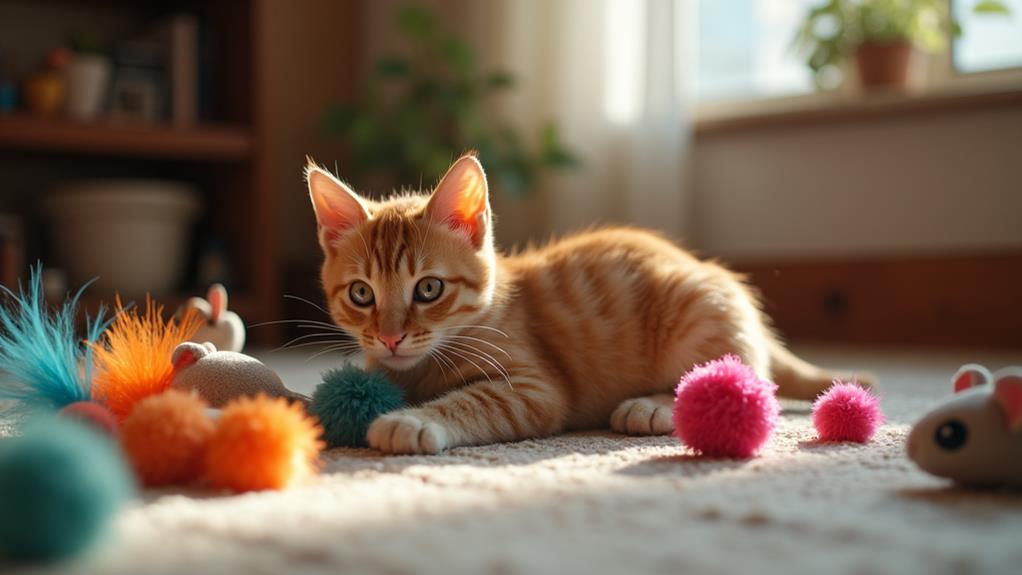How to Safely Tame a Feral Cat: Tips for Building Trust

To safely tame a feral cat, start by understanding their natural instincts and body language. Create a quiet, secure environment with a designated space for retreat. Establish a consistent feeding routine using strong-smelling foods, allowing distance to guarantee comfort. Let the cat approach at its own pace and offer treats as encouragement. Maintain calm and consistent interactions, like slow blinking and gentle speech, to signal trust. Engage in safe play using wand toys to foster positive interactions. Don't rush the process; observe their comfort levels through their body language. There's more to learn about guaranteeing a smooth, trusting bond.
Understanding Feral Cat Behavior
Feral cats, often misunderstood, primarily avoid human contact due to their natural survival instincts. These cats are born in the wild, and fear is their ally in staying safe. When you're trying to build trust with a feral cat, it's crucial to understand that each cat has its unique personality and timeline. Patience is more than a virtue here—it's a requirement. You can't rush the socialization process; doing so might stress the cat further and impede trust-building efforts.
Observing feline body language is critical. Look for signs of comfort or distress: a twitching tail or flattened ears indicate unease, while a gently waving tail and forward-facing ears suggest relaxation. Recognizing these cues helps you gauge when to approach or give space, allowing the cat to acclimate at its own pace.
Creating a Safe Environment
How can you create a welcoming space for a feral cat? Start by designating a safe spot, like a cozy bed or cat house, where they can retreat and feel secure. This area should be away from disturbances, providing the cat with a sense of comfort and safety. Incorporate familiar scents into this space by placing worn clothing or blankets nearby. These scents can help the cat feel more at ease, promoting trust-building as they associate the area with your presence.
Maintaining a quiet atmosphere is essential. Avoid loud noises and sudden movements, as these can startle the cat and hinder the development of trust. Keep the environment calm and predictable, allowing the cat to investigate and adjust at their own pace.
When setting up feeding areas, choose locations away from high-traffic zones. This not only minimizes stress but also guarantees that the cat can eat peacefully. Regularly check the surroundings for potential dangers, such as aggressive animals or busy roads, to safeguard the cat's safety.
Consistent Feeding Routine

Establishing a consistent feeding routine is vital for gaining a feral cat's trust. By providing food and water at the same time each day, you create a consistent feeding schedule that fosters predictability. This predictability helps the cat associate you with nourishment, making it more likely to approach and eventually trust you. Use strong-smelling foods like canned fish to attract the cat's attention and encourage it to return regularly to the feeding spot.
Choose a location for feeding and stick to it, so the cat recognizes it as a safe and reliable source of sustenance. By doing this, you're helping the cat feel secure and less wary of its surroundings. Monitor the amount of food you provide to avoid attracting unwanted wildlife or creating competition among other animals. Adjust the quantity as needed to maintain a balance.
While the cat eats, keep your distance. Avoid sudden movements or direct eye contact, as these can scare it away. Your patience in allowing the cat to eat peacefully will help it build trust at its own pace. Over time, this consistent routine will be a fundamental step in earning the cat's trust.
Building Trust Gradually
Once you've established a consistent feeding routine, you're ready to start building trust gradually with the feral cat. Allow the cat to approach you at its own pace. Forcing interaction can hinder trust and increase stress. Use food as a primary motivator. Offer high-value treats to encourage the cat to come closer without feeling threatened. During feeding times, remain calm and still. Avoid direct eye contact and loud noises to create a safe atmosphere for the cat.
Observe the cat's body language closely. This will help you gauge its comfort levels and readiness for interaction. Gradually decrease the distance between you and the cat over time, always ensuring it feels secure. Cats are naturally wary, so patience is key. Don't rush the process. Let the cat dictate the pace of the relationship.
Incorporate consistent routines for feeding and care. Predictability helps the cat associate you with safety and nourishment, which fosters trust. By maintaining a reliable schedule, you show the cat that you're not a threat. Building trust with a feral cat takes time, but with patience and understanding, you're laying the foundation for a rewarding relationship.
Interpreting Feline Body Language

Understanding feline body language is crucial when interacting with feral cats, as it provides insight into their emotions and comfort levels. Feral cats often communicate fear through their body language. Keep an eye out for low postures, tucked tails, and dilated pupils—all signs that the cat might need space. Recognizing these cues helps you build trust by respecting their boundaries.
Here's a quick guide to interpreting key body language signals:
- Tail Position: An upright tail usually signals confidence and contentment, whereas a puffed-up tail might indicate fear or aggression. Approach with caution if you see the latter.
- Eyes and Blinking: Slow blinking at a cat can show you're non-threatening. When a cat slowly blinks back, it usually feels safe and comfortable around you, which is a trust-building moment.
- Ear Position: Ears positioned forward suggest curiosity or interest. If the ears are flattened, the cat might be feeling fear or aggression. It's best to give them space in such cases.
- Whisker Position: Whiskers pointing forward indicate excitement or engagement, while whiskers pulled back can show discomfort or stress. Notice these changes to better understand the cat's emotional state.
Gentle Interaction Techniques
Recognizing feline body language lays the foundation for gentle interaction techniques with feral cats. When you approach a feral cat, begin by avoiding direct eye contact, as this can be seen as a threat. Instead, use slow blinking to signal non-aggression and show you're someone they can trust. Let the cat come to you at its own pace; forcing interaction can break the fragile trust you've started to build. Understanding a cat's body language will guide you in knowing when it's ready to engage.
Speak to the cat in a calm and soothing voice. This helps create a relaxing atmosphere, easing any anxiety the cat might feel. Offering high-value treats like tuna or wet baby food on a spoon can further encourage the cat to come closer. This positive reinforcement helps the cat associate you with good experiences, gradually establishing trust.
When the cat starts to feel more comfortable, slowly extend your hand for it to sniff and investigate. This approach respects the cat's boundaries and allows it to feel in control, which is crucial for building a trusting relationship. Remember, patience is key; it may take days or even weeks.
Safe Play and Toys

Playtime is an essential component of taming a feral cat, as it helps build trust and provides mental stimulation. To guarantee safe play, start with interactive wand toys placed on the floor. This approach allows the cat to engage at its own comfort level, fostering a positive association with you. Here are some tips to make playtime both safe and enjoyable:
- Use interactive toys: Begin with simple objects like pine cones or rattling mice. These toys stimulate the cat's natural instincts without overwhelming it, promoting a sense of control and safety.
- Introduce gentle movements: Gradually incorporate gentle movements and sounds during play. This helps the cat become accustomed to your presence, reducing perceived threats and building trust.
- Avoid unattended toys: Don't leave wand toys unattended, as they can cause stress if the cat feels trapped. Always supervise playtime to maintain a sense of security.
- Observe and adjust: Pay attention to the cat's reactions. Adjust the intensity and type of toys based on their comfort level to guarantee a positive experience.
Veterinary Care and Health
While safe play helps build trust with a feral cat, ensuring their health through regular veterinary care is just as vital. Establishing routine veterinary check-ups is important. These visits monitor their health, spot potential diseases, and keep vaccinations current, particularly for FeLV and FIV. This proactive approach can greatly reduce health risks and improve their quality of life.
One major step in managing a feral cat's health is ensuring they get spayed or neutered. Not only does this help with population control, but it also minimizes certain health risks. TNR (trap-neuter-return) programs are particularly effective in controlling feral populations and improving their general well-being.
Additionally, don't overlook the importance of dental health. Many feral cats suffer from untreated dental issues, which can lead to severe complications. Regular dental check-ups can prevent these problems, ensuring they maintain a healthy mouth.
Parasite prevention is another vital aspect of their care. Feral cats are often exposed to fleas, ticks, and intestinal parasites. Ensuring they receive proper treatments can protect them from these threats. Financial assistance for these important services is often available through local shelters and organizations, easing the burden of care.
Community Support Strategies

Engage your community to make a meaningful impact on feral cat welfare. By rallying together, you can tackle the challenges of caring for feral cats more effectively. Start by collaborating with local organizations and shelters. They offer valuable resources and support to guide your efforts, enhancing community education and awareness about feral cat issues. To guarantee consistent care, work with neighbors to create a feeding schedule. This not only provides regular nourishment for the cats but also builds a sense of shared responsibility.
Organizing a local volunteer group for Trap-Neuter-Return (TNR) is another powerful strategy. TNR helps manage cat populations humanely and improves their comprehensive health and safety. Hosting community events or workshops can further educate residents on responsible practices, promoting a collective approach to feral cat welfare.
Here's how you can take action:
- Collaborate with local organizations: Tap into existing resources and expertise.
- Set up a feeding schedule: Share the responsibility with neighbors.
- Form a TNR volunteer group: Actively manage and reduce cat populations.
- Host educational events: Spread awareness and promote best practices.
Share your success stories on social media to inspire and expand community involvement.
Patience and Persistence
Successfully taming a feral cat hinges on your patience and persistence. Each cat operates on its own timeline for trust development, which can take anywhere from weeks to months. By consistently maintaining a feeding routine, you establish familiarity and security, essential elements in creating a bond. Make feeding times predictable and routine, allowing the cat to associate you with comfort and sustenance.
While it might be tempting to rush interactions, let the cat initiate contact. Forcing interaction can increase its fear and stress, setting back your progress. Instead, observe the cat's body language to gauge its comfort level. Signs of relaxation, like a slow blink or a gentle stretch, indicate that the cat is starting to feel safe. Conversely, a tense posture or flattened ears signal discomfort; respect these cues to avoid setbacks.
Celebrate small milestones, such as the cat approaching you for food or engaging in playful behavior. These achievements signify growing trust and encourage you to remain persistent. By respecting the cat's pace and acknowledging these victories, you're fostering a positive environment where trust can gradually flourish. Patience, after all, is the key to revealing a feral cat's heart.




